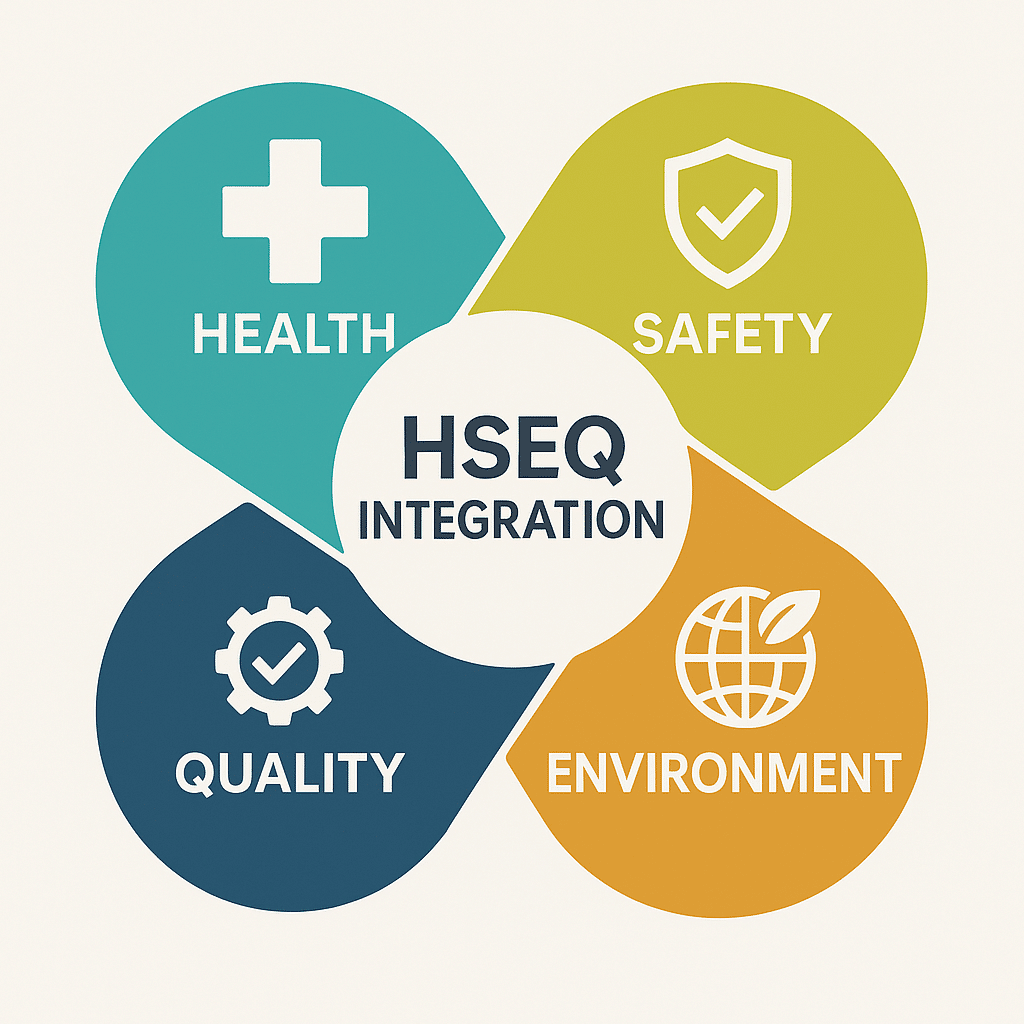HSEQ Integration is more than a buzzword—it’s a strategic approach that empowers organizations to align their health, safety, environment, and quality systems into a unified management framework.

Rather than treating these areas as isolated silos, successful HSEQ integration creates a holistic view of risk, performance, and continuous improvement. The result? Safer workplaces, better compliance, streamlined operations, and improved stakeholder confidence.
What Is HSEQ Integration?
HSEQ Integration refers to the process of combining multiple management systems—typically for occupational health and safety (OHS), environmental protection, and quality assurance—into a single, cohesive system. This integrated model simplifies governance, eliminates duplication, and aligns performance objectives across departments.
Instead of managing ISO 45001 (health & safety), ISO 14001 (environment), and ISO 9001 (quality) separately, organizations can establish one integrated HSEQ management system that meets all requirements simultaneously.
Benefits of HSEQ Integration
1. Improved Operational Efficiency
Running separate systems for HSE and quality often leads to redundant documentation, duplicated audits, and misaligned goals. Integration enables shared procedures, common reporting tools, and unified audits, which save time and reduce costs.
2. Enhanced Risk Management
By combining hazard identification, risk assessments, and quality control, organizations get a comprehensive view of risk exposure across operations. This proactive approach leads to better prevention strategies and fewer incidents.
3. Stronger Compliance and Certification Readiness
A well-integrated HSEQ system streamlines efforts to meet international standards such as:
- ISO 9001: Quality Management
- ISO 14001: Environmental Management
- ISO 45001: Occupational Health and Safety
With integrated processes, companies can pass audits with fewer non-conformities and less preparation time.
4. Simplified Training and Communication
When all HSEQ policies and procedures are aligned, training becomes more straightforward. Staff are trained on a unified management approach, making it easier to understand responsibilities and expectations.
5. Improved Culture and Accountability
Integration fosters a culture of shared ownership, where employees understand how health, safety, environment, and quality are interconnected. This collective responsibility enhances performance across all areas.
Steps to Implement HSEQ Integration Successfully
Step 1: Evaluate Existing Systems
Start by assessing your current OHS, environmental, and quality programs. Identify overlaps, inconsistencies, and areas where systems are operating in silos.
Ask:
- Are we using separate reporting tools?
- Are audits duplicated?
- Do policies conflict or overlap?
Step 2: Align Policies and Objectives
Create a unified HSEQ policy that reflects your organization’s vision and values across all domains. Align objectives to ensure consistency—for example, linking safety goals with quality outcomes and environmental impact.
Step 3: Standardize Procedures and Documentation
Develop integrated procedures that cover:
- Incident reporting
- Non-conformance and corrective actions
- Risk assessments
- Training records
- Internal audits
Use common templates, forms, and databases to ensure efficiency and clarity.
Step 4: Implement a Centralized HSEQ Software System
Digital tools like Intelex, ETQ Reliance, or EcoOnline can help you manage an integrated HSEQ framework with real-time dashboards, automated workflows, and centralized data repositories.
Step 5: Train and Engage Staff
Engagement is key. Train employees on:
- The purpose and benefits of integration
- Their specific roles in the HSEQ system
- Reporting and compliance expectations
Use internal champions to reinforce consistent behaviors and encourage ownership.
Step 6: Audit and Continuously Improve
Conduct integrated internal audits to evaluate effectiveness. Use findings to improve and adjust your HSEQ system over time. Remember, integration is not a one-time fix—it’s a dynamic, evolving process.
Common Challenges in HSEQ Integration (and How to Overcome Them)
| Challenge | Solution |
|---|---|
| Resistance to change | Involve teams early and communicate benefits clearly |
| Legacy systems and siloed data | Use integration software and central repositories |
| Conflicting departmental priorities | Align leadership and set shared performance indicators |
| Inconsistent terminology or definitions | Standardize language across policies and training |
| Multiple audit schedules | Develop a unified HSEQ audit calendar |
Real-World Example: HSEQ Integration in Construction
A mid-sized construction firm in Canada faced rising injury rates, environmental violations, and rework due to quality issues. Each department operated independently with separate policies and audit systems. After integrating their HSEQ systems:
- They reduced incident rates by 35% in one year
- Audit costs dropped by 40%
- Rework due to quality defects declined by 50%
The key was cross-functional collaboration, shared metrics, and leadership commitment to a unified vision.
How HSEQ Integration Supports Sustainability and Corporate Responsibility
Beyond compliance and performance, HSEQ integration supports sustainability goals and corporate social responsibility (CSR). A well-aligned system allows companies to:
- Track carbon emissions alongside quality and safety KPIs
- Reduce waste through more efficient operations
- Demonstrate transparency to regulators, investors, and communities
It also aligns with ESG (Environmental, Social, Governance) reporting—a growing priority for global organizations.
Conclusion: HSEQ Integration Is a Competitive Advantage
HSEQ Integration is more than just a systems upgrade—it’s a strategy for long-term success. By unifying health, safety, environment, and quality efforts, organizations reduce risk, lower costs, improve compliance, and foster a stronger safety culture.
In today’s competitive and regulated markets, integrated HSEQ management is no longer optional—it’s essential.
Leave a Reply